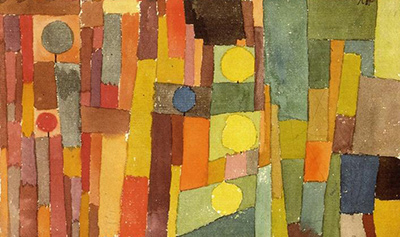The abstract-expressionist watercolour and pencil painting on paper, In the Style of Kairouan, painted by Paul Klee in 1914, is kept in the Kuntsmuseum Bern in Switzerland close to Munchenbuchsee where the artist was born in 1879.
Kairouan, in Tunisia, is a place Klee visited together with the artists Louis Moilliet and August Macke.
In this painting Klee has progressed from having recognizable imagery and has replaced this with abstract rectangles, polygons and circles in a wide range of colours.
The building blocks of this painting are the coloured rectangles. Some scholars see these, because of the artist's musical background, as musical notes and the whole picture as equivalent to a musical composition.
Some see the composition as starting with the central rectangle with other rectangles being added to suggest some sort of flow from the original 'note'. Perhaps it was meant to, at least, suggest a musical aura.
The painting may have been an intellectual game to leave its watchers guessing. Whatever its meaning this colourful painting was, undoubtedly, a pivotal moment for Klee who went on to become an important twentieth-century artist.
Background to the painting's creation
Paul Klee came from a musical family, playing the violin when young, but he also had drawing skills and became a graphic artist but, at that time, not one that worked in colour. In 1898 Klee went to study at Munich's Academy of Fine Arts and later joined Der Blaue Reiter's editorial team which included August Macke and Wassily Kandinsky.
Reading the writings of Kandinsky inspired Klee who went on to explore colour theory which gave practical guidance as how to achieve desired visual effects in colour by mixing them together. This resulted in a progression for the artist from black and white works to ones that included colour. It wasn't until 1914, however, when he visited Tunisia that he declared that 'colour and I are one' having been greatly impressed by the light there. It was shortly after his return that Klee painted In the Style of Kairouan which was to be his first truly abstract work.




